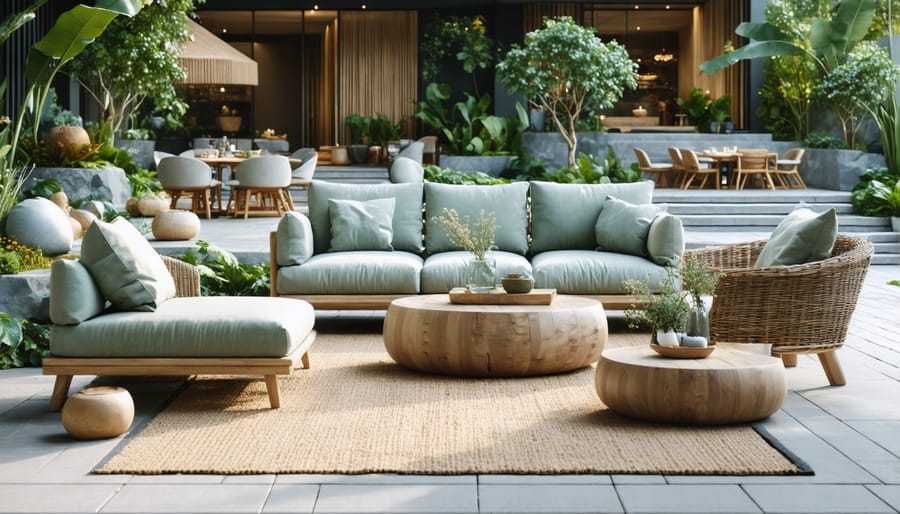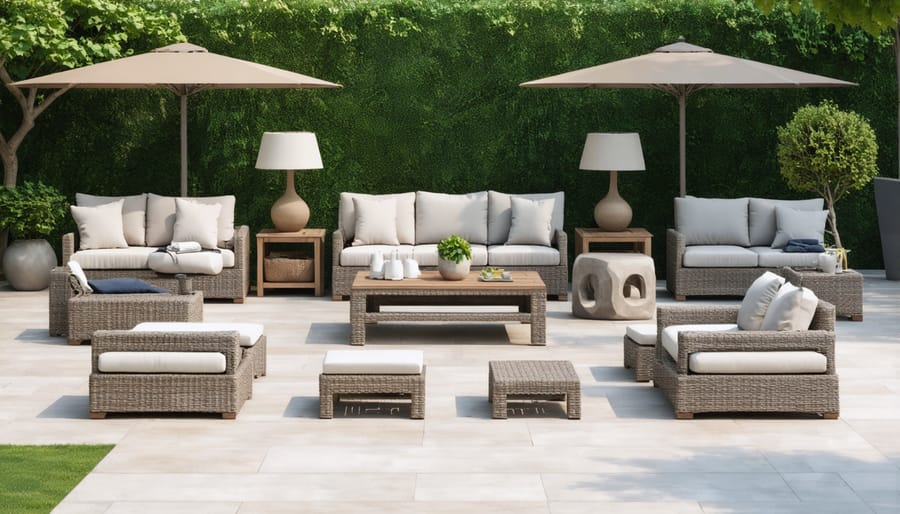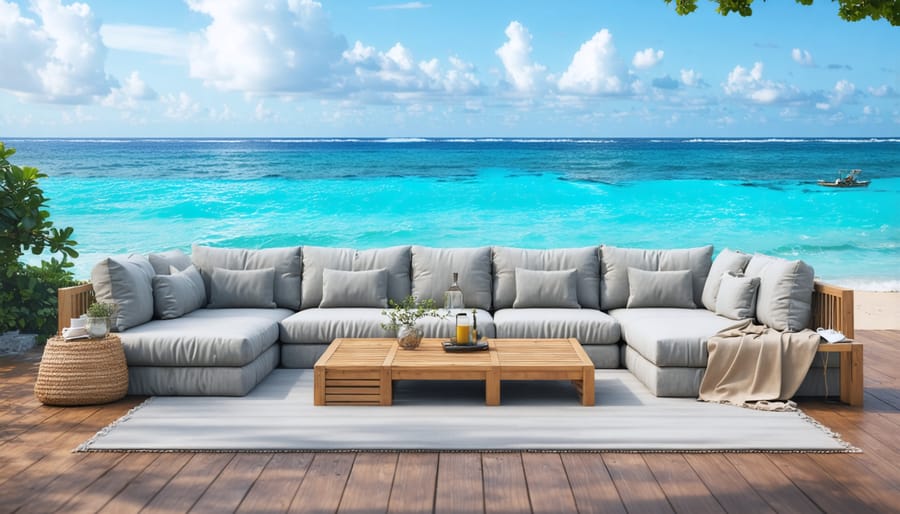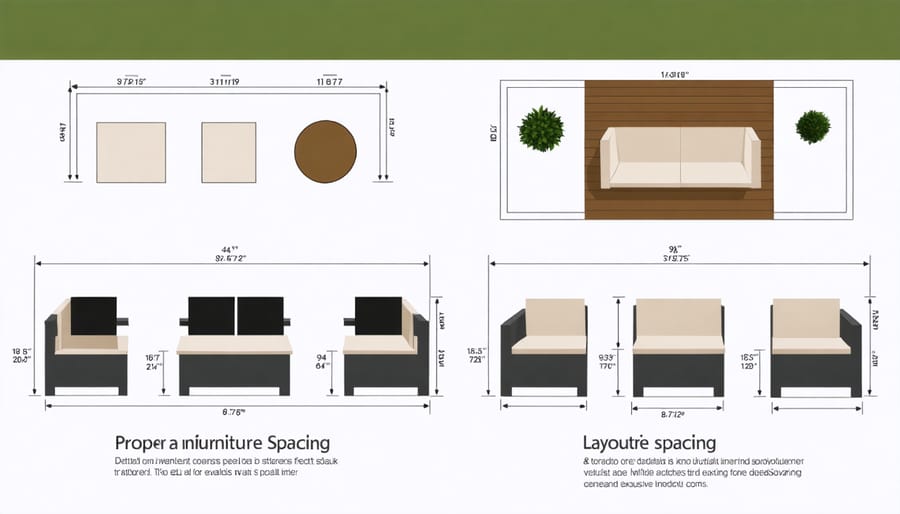
Weatherproof Your Patio: Smart Outdoor Furniture Choices That Last
Transform your outdoor living space into a year-round retreat by mastering the essentials of choosing patio furniture. Select weather-resistant materials like powder-coated aluminum or teak for longevity, ensuring your investment withstands sun, rain, and seasonal changes. Consider your climate and storage capabilities when selecting pieces – lightweight, stackable furniture offers flexibility for small spaces and winter storage, while heavier materials provide stability in windy conditions. Match your furniture’s durability to your local weather patterns: marine-grade stainless steel for coastal areas, UV-resistant synthetics for sun-drenched patios, or moisture-resistant woods for rainy regions. Factor in your lifestyle needs – from intimate bistro sets for morning coffee to expansive sectionals for entertaining – while keeping maintenance requirements aligned with your available time and resources. Your outdoor furniture should create a seamless transition between indoor comfort and outdoor living, balancing style, functionality, and durability.

Weather-Resistant Materials That Stand the Test of Time
All-Weather Wicker and Resin
All-weather wicker and resin furniture offers the perfect blend of classic style and modern durability. Unlike natural wicker, these synthetic materials resist fading, cracking, and weathering, making them ideal for outdoor spaces. The UV-resistant properties ensure your furniture maintains its color and integrity even under direct sunlight.
Maintenance is remarkably simple – just wipe down with mild soap and water, then rinse thoroughly. For deeper cleaning, use a soft brush to remove debris from the weave pattern. During severe weather, while these pieces are highly durable, it’s still wise to store them or use furniture covers for maximum longevity.
These pieces come in various styles and colors, from traditional to contemporary, and can last for many years with proper care. The lightweight nature of resin wicker also makes it easy to rearrange your outdoor space as needed.
Teak and Other Hardwoods
Teak stands out as the gold standard for outdoor wood furniture, thanks to its natural oils that resist rot, insects, and weather damage. This tropical hardwood develops a distinguished silver-gray patina over time, though you can maintain its honey-brown color with regular oiling. While teak commands a premium price, its longevity often justifies the investment.
Other hardwood options include acacia, eucalyptus, and shorea, which offer similar weather-resistant properties at more affordable price points. These alternatives provide excellent durability when properly maintained with annual sealing or oil treatments. For optimal longevity, store wooden furniture indoors during harsh weather or use protective covers when exposure can’t be avoided. Consider pieces made from sustainably harvested wood to ensure environmental responsibility while enjoying the timeless appeal of natural materials.
Aluminum and Steel Options
Metal outdoor furniture offers exceptional durability and modern appeal, with aluminum and steel being top choices for contemporary outdoor spaces. Aluminum pieces are naturally rust-resistant and incredibly lightweight, making them perfect for frequently rearranged areas like patios and pool decks. While aluminum furniture typically costs more upfront, its low maintenance requirements and longevity make it a smart long-term investment.
Steel furniture provides superior stability and weight, ideal for windy locations. Modern steel pieces feature powder-coating or galvanized finishes that significantly enhance rust resistance. When choosing steel furniture, look for welded joints and protective feet to prevent scratching on decking. Both aluminum and steel options clean easily with mild soap and water, though it’s recommended to cover them during harsh weather for maximum longevity. For coastal areas, aluminum is typically the better choice due to its superior corrosion resistance.
Marine-Grade Fabrics
When it comes to outdoor cushions and upholstery, marine-grade fabrics are your best bet for long-lasting comfort and style. These durable outdoor fabrics are specially engineered to withstand harsh elements like sun, rain, and salt air. Popular options include Sunbrella, Outdura, and other solution-dyed acrylic materials that resist fading, mold, and mildew. These fabrics feel soft and comfortable while maintaining their color and shape through multiple seasons. Look for options with UV protection and water-resistant treatments for the best performance. Many marine-grade fabrics now come in a wide range of colors and patterns, making it easy to match your outdoor décor while ensuring lasting durability.
Choosing Furniture for Your Climate
Coastal Considerations
Living by the coast presents unique challenges for outdoor furniture, with salt air and high humidity being particularly demanding on materials. Marine-grade stainless steel and aluminum are excellent choices for coastal environments, as they resist corrosion and rust better than standard metals. Look for grade 316 stainless steel specifically, as it offers superior protection against salt spray.
High-density polyethylene (HDPE) and resin furniture are also smart options, as they won’t corrode, rot, or fade significantly in coastal conditions. These materials can withstand salt air while requiring minimal maintenance beyond regular cleaning.
Teak remains a premium choice for coastal areas, thanks to its natural oils that resist moisture and salt damage. While it will eventually weather to a silvery-gray patina, this aging process doesn’t affect its durability.
When selecting cushions and fabrics, opt for solution-dyed acrylic materials like Sunbrella, which resist fading and mildew. Store cushions in a protective container when not in use to extend their life.
Regular maintenance is crucial in coastal areas – rinse furniture frequently to remove salt deposits, and apply appropriate protective coatings to metal pieces annually. Consider furniture covers for additional protection during severe weather or off-season storage.

Desert and High-Sun Environments
In desert and high-sun environments, choosing the right outdoor furniture materials is crucial for longevity and comfort. Metal furniture, particularly aluminum and powder-coated steel, excels in these conditions as they resist heat absorption and maintain structural integrity under intense UV exposure. Look for pieces with UV-resistant finishes to prevent fading and deterioration.
Synthetic wicker made from high-density polyethylene (HDPE) offers excellent sun resistance and won’t crack or fade like natural materials. These pieces often come with UV inhibitors built into the material, ensuring years of service even in the harshest conditions.
For cushions and upholstery, opt for solution-dyed acrylic fabrics like Sunbrella, which maintain their color and strength even after years of sun exposure. These materials are specifically engineered to withstand intense desert heat while remaining comfortable to touch.
Teak and other dense hardwoods can also perform well in desert environments, though they’ll require more maintenance to prevent drying and cracking. Regular application of UV-protective sealants and wood oils will help maintain their appearance and strength.
Consider adding shade solutions like umbrellas or pergolas to extend your furniture’s life and create comfortable outdoor living spaces during peak sun hours.
Space Planning and Style Selection
Measuring Your Space
Before purchasing outdoor furniture, it’s crucial to accurately measure your space to ensure proper fit and flow. Start by sketching your outdoor area on graph paper, noting the total square footage and any fixed features like doors, steps, or built-in elements. Remember to leave adequate pathways of at least 30 inches between furniture pieces for comfortable movement.
For dining areas, allow 24-30 inches of space per seated person and ensure there’s at least 42 inches of clearance around the table for chairs to pull out easily. If you’re planning a year-round outdoor living space, consider creating distinct zones for dining, lounging, and entertaining.
When measuring for conversation sets or seating areas, maintain 18 inches between the coffee table and seating. L-shaped sectionals should have at least 24 inches of space from walls or railings. Don’t forget to account for décor elements like planters, lighting fixtures, or outdoor kitchen equipment.
Take photos of your space and keep measurements handy while shopping. Many retailers offer printable furniture templates you can use to test different arrangements before making a purchase. Remember that while maximizing seating is important, an overcrowded space will feel uncomfortable and limit functionality.

Style Matching
Creating a harmonious flow between your indoor and outdoor spaces starts with thoughtful style matching. Your outdoor furniture should complement your home’s architectural style and interior design scheme to create a seamless transition from inside to outside.
For traditional homes with classic architecture, opt for furniture with timeless designs, such as wrought iron pieces with curved details or teak furniture with elegant lines. These choices echo historical elements while maintaining sophistication. Colonial or Victorian-style homes pair beautifully with ornate metal furniture or classic wicker pieces in neutral tones.
Modern and contemporary homes call for clean lines and minimalist designs. Consider sleek aluminum furniture, modular seating arrangements, or geometric patterns. Industrial-style properties work well with metal furniture featuring raw finishes and simple forms.
When coordinating with your interior decor, look at your color palette and design elements. If your indoor space features warm woods and earth tones, choose outdoor furniture that incorporates similar materials and colors. For homes with contemporary interiors, maintain consistency by selecting outdoor pieces with comparable modern aesthetics.
Don’t forget about textiles – your outdoor cushions and pillows should complement your interior color scheme while using weather-resistant materials. This creates visual continuity and makes your outdoor space feel like a natural extension of your home.
Maintenance and Protection Tips
Seasonal Care Guide
Keep your outdoor furniture looking its best year-round with these seasonal maintenance tips. In spring, give your furniture a thorough cleaning to remove winter debris and inspect for any damage. Use mild soap and water for most materials, and apply appropriate protective treatments based on your furniture type.
During summer, regularly brush off leaves and dirt, and clean bird droppings promptly to prevent staining. Consider using furniture covers during intense sun exposure to prevent fading, and move cushions indoors during heavy rain.
Fall maintenance should focus on preparing for winter. Clean thoroughly, repair any loose parts, and apply protective sealants if needed. Store cushions indoors and ensure furniture covers are secure.
For winter, either store furniture indoors or use heavy-duty weatherproof covers. If storing outside, elevate furniture off the ground to prevent moisture damage. For metal furniture, check for rust spots and treat them immediately to prevent spreading.
Remember to maintain your furniture covers throughout the year, cleaning them regularly and checking for tears or damage that could compromise their effectiveness.
Storage Solutions
Protecting your outdoor furniture from severe weather is crucial for extending its lifespan. For temporary storage, consider waterproof furniture covers that are specifically designed for your pieces. These covers should be breathable to prevent moisture buildup while keeping rain and debris away from your furniture.
If you have a garage or shed, these make excellent seasonal storage spaces. Before storing, clean and dry your furniture thoroughly to prevent mold and mildew. For those without dedicated storage areas, look into deck boxes or storage benches that serve dual purposes – they protect smaller items while providing additional seating.
For apartment dwellers or those with limited space, consider furniture that folds or stacks easily. Many modern outdoor pieces are designed with storage in mind, featuring compact folding mechanisms or nesting capabilities. You might also explore vertical storage solutions, such as wall-mounted hooks for chairs or hanging systems for cushions.
During extreme weather events like hurricanes or severe storms, move lighter furniture indoors or secure it firmly to prevent wind damage. Remember to store cushions and pillows separately in waterproof containers to maintain their quality and extend their life.
Smart Investment Strategies
Making smart investments in outdoor furniture requires careful planning and strategic shopping. Start by focusing on high-quality materials that offer the best value for your money. While premium teak or wrought iron pieces may cost more initially, their durability often justifies the investment. For budget-friendly furniture shopping, consider buying during off-season sales, typically in late summer or early fall, when retailers offer significant discounts.
Prioritize essential pieces first, such as a comfortable seating set or dining table, before adding decorative elements. Look for modular furniture that can be rearranged or expanded later, giving you flexibility as your needs change. Multi-functional pieces, like storage ottomans or convertible tables, offer excellent value by serving multiple purposes.
Consider purchasing protective covers along with your furniture to extend its lifespan and protect your investment. This small additional cost can save hundreds in replacement furniture over the years. When possible, opt for neutral colors and classic styles that won’t quickly become dated, allowing you to update your outdoor space with less expensive accessories like pillows and throws.
Watch for floor models or slightly imperfect pieces that retailers may offer at substantial discounts. Often, minor flaws are barely noticeable but can lead to significant savings. Finally, don’t overlook warranties and maintenance requirements when comparing prices – a cheaper set that needs frequent replacement or extensive upkeep might cost more in the long run than a pricier, low-maintenance option.
Choosing the right outdoor furniture is an investment in your lifestyle and home value. Throughout this guide, we’ve explored the crucial factors that influence outdoor furniture decisions, from material selection to climate considerations. Remember that the best choice combines durability, comfort, and style while matching your specific outdoor environment and maintenance capabilities.
For long-lasting satisfaction with your outdoor furniture, prioritize weather-resistant materials appropriate for your climate, invest in proper protection and storage solutions, and maintain a regular cleaning schedule. Consider your space’s layout and functionality needs before making purchases, and don’t forget to account for seasonal changes and storage requirements.
Whether you’re furnishing a small balcony or an expansive patio, quality should always be your priority. While budget-friendly options exist, investing in well-made pieces often proves more economical in the long run. By following the guidelines in this guide, you’ll be well-equipped to create an inviting outdoor living space that brings years of enjoyment and stands up to the elements.
